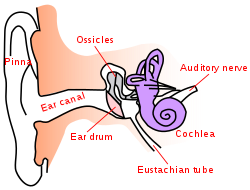Conductive hearing loss

Editor-In-Chief: Prab R Tumpati, MD
Obesity, Sleep & Internal medicine
Founder, WikiMD Wellnesspedia &
W8MD medical weight loss NYC and sleep center NYC
| Conductive hearing loss | |
|---|---|

| |
| Synonyms | N/A |
| Pronounce | N/A |
| Specialty | N/A |
| Symptoms | Hearing loss, ear fullness, tinnitus |
| Complications | Social isolation, communication difficulties |
| Onset | Any age |
| Duration | Varies |
| Types | N/A |
| Causes | Earwax, otitis media, otosclerosis, ear canal obstruction |
| Risks | Ear infections, head trauma, genetic factors |
| Diagnosis | Audiometry, tympanometry, otoscopy |
| Differential diagnosis | Sensorineural hearing loss, mixed hearing loss |
| Prevention | N/A |
| Treatment | Hearing aids, surgery, earwax removal |
| Medication | N/A |
| Prognosis | Generally good with treatment |
| Frequency | Common |
| Deaths | N/A |
Conductive hearing loss is a type of hearing loss that occurs when the transmission of sound from the external ear, through the middle ear to the inner ear is blocked or reduced. This can be caused by a variety of factors, including blockage in the ear canal, damage to the ear drum, or problems with the bones in the middle ear.
Causes[edit]
The most common cause of conductive hearing loss is otitis media, an infection of the middle ear. Other causes can include:
- Earwax blockage
- Otosclerosis, a condition where the bones in the middle ear become stiff
- Damage to the eardrum
- Cholesteatoma, a skin growth that occurs in the middle ear
- Otitis externa, an infection of the outer ear canal
Symptoms[edit]
The main symptom of conductive hearing loss is a reduction in hearing sensitivity. This can be accompanied by other symptoms such as:
- Pain in the ear
- Discharge from the ear
- Tinnitus, a ringing or buzzing noise in the ear
- Vertigo, a sensation of spinning
Diagnosis[edit]
Conductive hearing loss is diagnosed through a series of tests, including:
- Audiometry, a test that measures a person's ability to hear sounds
- Tympanometry, a test that measures the movement of the eardrum
- Otoscopy, a visual examination of the ear canal and eardrum
Treatment[edit]
Treatment for conductive hearing loss depends on the cause. It can include:
- Medication to treat infections
- Surgery to repair damage to the ear
- Hearing aids to amplify sound
See also[edit]
Ad. Transform your life with W8MD's Budget GLP-1 injections from $75


W8MD offers a medical weight loss program to lose weight in Philadelphia. Our physician-supervised medical weight loss provides:
- Weight loss injections in NYC (generic and brand names):
- Zepbound / Mounjaro, Wegovy / Ozempic, Saxenda
- Most insurances accepted or discounted self-pay rates. We will obtain insurance prior authorizations if needed.
- Generic GLP1 weight loss injections from $75 for the starting dose.
- Also offer prescription weight loss medications including Phentermine, Qsymia, Diethylpropion, Contrave etc.
NYC weight loss doctor appointmentsNYC weight loss doctor appointments
Start your NYC weight loss journey today at our NYC medical weight loss and Philadelphia medical weight loss clinics.
- Call 718-946-5500 to lose weight in NYC or for medical weight loss in Philadelphia 215-676-2334.
- Tags:NYC medical weight loss, Philadelphia lose weight Zepbound NYC, Budget GLP1 weight loss injections, Wegovy Philadelphia, Wegovy NYC, Philadelphia medical weight loss, Brookly weight loss and Wegovy NYC
|
WikiMD's Wellness Encyclopedia |
| Let Food Be Thy Medicine Medicine Thy Food - Hippocrates |
Medical Disclaimer: WikiMD is not a substitute for professional medical advice. The information on WikiMD is provided as an information resource only, may be incorrect, outdated or misleading, and is not to be used or relied on for any diagnostic or treatment purposes. Please consult your health care provider before making any healthcare decisions or for guidance about a specific medical condition. WikiMD expressly disclaims responsibility, and shall have no liability, for any damages, loss, injury, or liability whatsoever suffered as a result of your reliance on the information contained in this site. By visiting this site you agree to the foregoing terms and conditions, which may from time to time be changed or supplemented by WikiMD. If you do not agree to the foregoing terms and conditions, you should not enter or use this site. See full disclaimer.
Credits:Most images are courtesy of Wikimedia commons, and templates, categories Wikipedia, licensed under CC BY SA or similar.
Translate this page: - East Asian
中文,
日本,
한국어,
South Asian
हिन्दी,
தமிழ்,
తెలుగు,
Urdu,
ಕನ್ನಡ,
Southeast Asian
Indonesian,
Vietnamese,
Thai,
မြန်မာဘာသာ,
বাংলা
European
español,
Deutsch,
français,
Greek,
português do Brasil,
polski,
română,
русский,
Nederlands,
norsk,
svenska,
suomi,
Italian
Middle Eastern & African
عربى,
Turkish,
Persian,
Hebrew,
Afrikaans,
isiZulu,
Kiswahili,
Other
Bulgarian,
Hungarian,
Czech,
Swedish,
മലയാളം,
मराठी,
ਪੰਜਾਬੀ,
ગુજરાતી,
Portuguese,
Ukrainian
